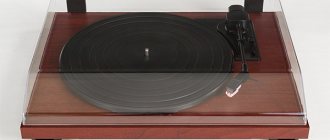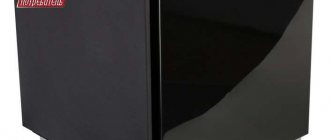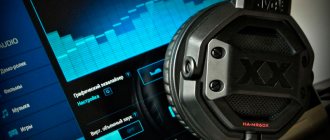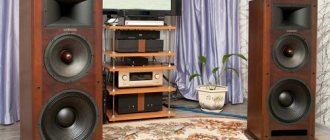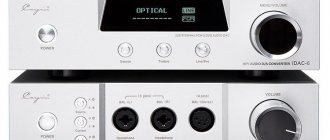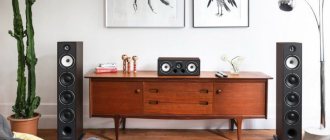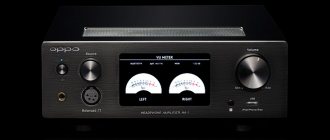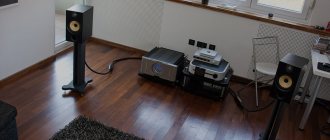- Technique
- Equipment catalog
- Blu-ray/DVD players
- Blu-ray players
- Oppo BDP-95
- Photo (2)
- Video (0)
I want to buy 14
I am the owner of 14
| Region: | ABC |
| BD profile: | BD-Live (2.0) |
| Blu-ray 3D support: | |
| 4K UHD Blu-ray support: | |
| 4K upscaling: | |
| SACD support: | |
| DVD-Audio support: | |
| HDMI Version: | 1.4 |
| Ethernet: | |
| WiFi: | |
| Internet services: |
- Description
- Review
- Reviews (0)
- Characteristics
- Comparison
- Firmware/Manuals
AUDIOPHILE. Review of universal Blu-ray players OPPO BDP-93, BDP-95.
John Gatsky. June 24, 2011
Two years ago, the OPPO BDP-83 and its improved version, equipped with a more expensive DAC, BDP-83SE, appeared. Purchasing the BDP-83 for $499 could be considered a bargain, and in the sub-$1000 category, the BDP-83SE raised the bar of quality among devices equipped with a higher-quality DAC. It was difficult for Blu-ray players from other manufacturers to compete with the ORPO BDP-83, but conditions in the audio market; Video products are changing quickly and the ability to play 3D video and receive streaming audio via Wi-Fi has become the next standard of functionality. If OPPO wants to maintain its leading position in the market, its players must produce not only high-quality sound and image, but also correspond to the spirit of the times.
Blu-Ray media players Oppo BDP-93 and Oppo BDP-95
Home → Articles → Blu-Ray media players Oppo BDP-93 and Oppo BDP-95Blu-Ray 3D media players Oppo BDP-93 and Oppo BDP-95.
In this article we will take a closer look at the Oppo BDP-93 model. Therefore, let’s immediately note the main differences
models BDP-93 and BDP-95.
Oppo BDP-95 is additionally equipped with a 32-bit SABER digital-to-analog converter, a powerful toroidal transformer in the power supply and a new and improved audio channel. And also a built-in Wi-Fi adapter. Oppo BDP-95 will be of interest to people who focus not only on watching high-quality videos, but also on listening to music. In all other respects, both models are almost identical, even in design.
OPPO BDP-93
OPPO BDP-95
Design and equipment.
The device comes in a convenient box and is reliably protected from damage. The package includes everything you need. Details can be seen in the photo.
BDP-93 is a stylish and solid device that will decorate any rack with expensive equipment. The front panel of the player is made of anodized aluminum, the control buttons are flush with the front panel. Comfortable feet prevent the player from pressing against the surface, and it is important that the cooling is passive. Dust and fingerprints collect on the player within acceptable limits.
The remote control in the BDP-93 is slightly more average in size and is convenient both in terms of the number of buttons and ergonomics. In addition, the buttons are made of translucent rubber and can be illuminated in the dark.
Opportunities and non-trivial filling.
The 90th series of Blu-Ray players from Oppo replaced the successful 80th and, in addition to a number of improvements in hardware, supports playback of almost all currently existing formats:
- Play any Blu-Ray and Blu-Ray 3D movies from hard drives
; - Play other popular video and audio formats from hard drives;
- Plays any optical discs (Blu-Ray, Blu-Ray 3D, DVD-Video, CD, SACD, DVD-Audio, etc.)
- Play content from the Internet.
The pride of both models is their video processor
. For video processing, the Oppo BDP-93 and Oppo BDP-95 use the Kyoto-G2 video processor with second-generation Qdeo technology from the famous manufacturer of video chips Marvell.
All sorts of image settings are available in the player menu: improving color reproduction, filtering video noise and video compression artifacts, contrast, brightness and detail.
Separately, it is worth noting the 1080 True 24p mode, which allows you to achieve playback that feels close to film. In essence, we are talking about an image without the slightest hint of jitter. Owners of this player have the opportunity to use the Source Direct mode (previously familiar from Pioneer technology), in which the original audio and video content will be output to an external video processor or AV receiver without any processing.
In terms of the number and quality of connectors, the BDP-93 does not give a single reason to complain. Availability of two HDMI
1.4 allows you to independently transmit audio and video streams or
simultaneously
display a movie, for example, on a TV and a projector.
The 3D
image can be transferred from one of the HDMI connectors directly to a video display device, and the sound can be transferred to a regular receiver.
This will allow you not to upgrade your AV receiver
to a new one that supports 3D. The player also provides an analog component video output. But depending on the activation of various settings in the menu and the inclusion of the processor, there may be certain restrictions on the HDMI and component interface. To get a reference picture, you should use the full power of the processor and use the HDMI output. For audio output, in addition to HDMI, there is a 7.1 analog output and digital outputs - optical and coaxial.
To connect content storage, the BDP-93 and 95 have USB, eSATA connectors, an Ethernet network port and a wireless Wi-Fi adapter.
The insides of the player once again demonstrate the difference in build quality between Chinese consumer goods and a premium product. Everything is done as carefully as possible, the layout is thought out to the smallest detail.
The player has a 2 GB flash memory installed on board, half of which is allocated for working with BD-Live. And after special tuning, the device can play DVD and Blu-Ray of any regional zone.
Impressions from use.
Interface.
The BDP-93's interface will be immediately clear to those who have already interacted with network players. Unlike the often overloaded main menu of media players and budget Blu-Ray players, everything here is concise: Photos, Movies, Music, Network Services and Settings. You can also move a couple of the most important services to the top (this is done in the latest US firmware). There are dozens of settings in the audio and video settings that will help you achieve the best possible performance.
Video.
When playing content from a computer/HTPC/laptop or inexpensive media player, there is a lack of contrast and black depth, as well as slight slowdowns in motion transmission. On PC, the lack of smoothness in the transmission of motion due to frame rate synchronization is especially noticeable when the entire frame passes from left to right. Oppo, like normal media players like Dune, has smooth movements
.
As for the color or contrast settings, theoretically you can achieve the result on a PC, but it will take a lot of time and all these settings go off too often. But Oppo, with its second generation Qdeo and various picture enhancers, makes everything much easier, and color reproduction comes out a little better. In the case of a media player, with the exception of 2-3 brands, the problem is the eternally crude software and weak hardware, which is designed not for the best picture, but for conquering the threshold of quality in the mass consciousness. Content on Oppo can be served from hard drive, flash drive, optical drive and network storage (excluding DVD, Blu-Ray and 3D ISO image structures). An important point was the omnivorous nature of formats
.
More or less current information about support for media formats can be found here: https://wiki.oppodigital.com/index.php?title=BDP-93_Media_Files_FAQ
The built-in software player can update automatically (but I don’t advise you to do this - the reason is just below). New firmware versions are released on average once every month and a half, and OPPO engineers provide the new version with comments about what has been improved or changed in it. But since November 2011, the company began to screw up its customers and cancel early functionality in new firmware. For example, ISO is not supported in BDP-9x players starting with firmware Beta 64-0119B and later
(this is done for copyright reasons). Previous support for this functionality is now considered unofficial and is no longer planned. Mkv and ts can be played normally on any media, as well as various music formats. Due to the fault of the firmware and to control copyright compliance, the buyer receives various shortcomings in terms of reading Blu-Ray from downloaded folders and images. Without these nuances, Oppo was an almost perfect network player via DLNA. We hope that the new firmware will not affect 3D Blu-Ray support, for which many have chosen Oppo in the last six months.
The BDP-93 has one of the record speeds for loading Blu-Ray discs. Mass-produced Samsung or LG models sometimes spin disks for 30-50 seconds, but here there is no trace of that. The player allows you to avoid the tedious wait before watching your favorite movie. Only Blu-Ray content allows you to fully appreciate the splendor of colors, detail in the frame,
balanced contrast and brightness.
Oppo, quality comes first.
This means that on any bad video or in dynamic fragments with a lack of bitrate, all the flaws in the source can creep onto the screen. The player also handles the 1080i comb very well. But if the BDP-93 deserves an excellent rating when working with HD content, the real advantages of the Qdeo processor are visible in scaling and processing SD/DVD material. If we compare the Oppo BDP-93 with competitors such as Sony, Pioneer or Panasonic players, I can answer on average that the picture is somewhat soft (which, however, is noticeable when compared head-on only on a number of Blu-Ray discs). On specific video material, this nuance can be eliminated by fine-tuning the display parameters.
Audio.
The BDP-93 player does not give in to any HD sound
(Dolby Digital Plus, True HD and DTS HD).
Plus, the BDP-93 is one of the few on the market that can play DVD-A and SACD, and also output a DSD stream via HDMI. The sound demonstrated by the device when listening to music as part of a stereo system clearly indicates a high level of the sound path
.
The best level of audio sound is provided by the older model BDP-95.
It is worth noting that based on the Oppo DBP-93, NuForce produces audiophile tuned players OPPO BDP-93 NuForce Edition and OPPO BDP-93 NuForce Extreme Edition. They are able to produce an even more holistic and high-quality sound and better convey the sound of stringed instruments, and the bass is more collected and accurate. At the same time, the location of the instruments is perfectly felt.
Internet services.
And finally, about additional features. The player provides access to Netflix, Blockbuster, CinemaNow and other popular resources with online video or video-on-demand. But here lies a small problem. Even for the European model, all services in the database, with rare exceptions, come with American registration and therefore will be of little relevance. Well, for a resident of Russia or Ukraine - even more so. The situation is strange, especially considering the presence in Europe of 5-7 major players in this market who do not mind integrating into popular players.
Conclusion.
What do we have in the bottom line? Oppo is a “ tuned Dune”
» is a player for people who are especially demanding about picture and sound quality.
The audio path in Oppo is clearly better, and video processing is at the highest level. If the picture of older Dune models in comparison with mass-produced Realtek players is 10 versus 7, then when Oppo is included in the comparison, Dune will deserve 8.5-9, and Oppo a full 10
.
Therefore, for people who value the quality of Blu-Ray films, the BDP-93 or BDP-95 will be a real gift. Oppo stands out for its reliability, excellent audio and video characteristics, reads optical discs faster, and most importantly, plays any Blu-Ray movies from hard drives (including 3D)
.
And finally, a few words about comparison with expensive Hi-End brands. Some “experts” immediately label it when they learn that Oppo is a brand under the roof of the well-known BBK for the US market. Yes, the company has Chinese roots, but serious financial resources and the best team of engineers and programmers gave Oppo the opportunity to become one of the market leaders. It is indicative that expensive Hi-End brands use Oppo products as the basis for their expensive Blu-Ray players! Of course, you can admire the top models of Denon or Marantz, but the two and three times difference in price is hardly worth the minuscule difference in image and sound quality, as well as the loss of 3D and the ability to create collections on hard drives (Denon still, at the very least, reproduces Blu-Ray remixes , and Marantz is a purely optical player). To summarize, we can say that the Oppo BDP-93 and BDP-95 players are the optimal Blu-Ray media players in terms of characteristics, price and quality. Pros:
- Design, delivery set;
- Plays all popular formats from hard drives
, including Blu-Ray and Blu-Ray 3D with menu. - A full set of communication connectors;
- Thoughtful and ergonomic menu;
- Reference quality SD content;
- Excellent HD video quality;
- High quality HD audio and DVD audio.
Minuses:
- Blu-Ray 3D from hard drives is not supported on new firmware, starting with Beta 64-0119B;
- You cannot watch full Blu-Ray discs (with menus) or Blu-Ray 3D from NAS servers. Only Blu-Ray remixes are possible;
- You cannot watch DVDs from hard drives;
- Limited internet functionality (compared to Dune and Iconbit).
← all articles
OPPO BDP-93
Let's start with the BDP-93. It has the same Cirrus Logic CS4382 DAC as the BDP-83, but differs from it in two HDMI 1.4a outputs with 3D support, streaming audio reception and access to Internet resources Netflix, Pandora, YouTube and others via Wi-Fi. The appearance has become more stylish due to changes in the facade and replacement of the button control zone with a touchscreen to match the elegant front panel. In the video part, the Anchor Bay processor was replaced by the 2nd generation Marvel QdeoTM processor, the optical disk transport was redesigned, which improved the quality of its mechanics, and a more rigid case better resists vibration. The rear panel indicates the serious switching capabilities of the device. In particular, there is a LAN port, 2xHDMI 1.4a with 3D support and the possibility of separate image and sound output, eSATA for connecting external HDD drives. For integration with control systems, there is an RS-232C port and an input for an external IR receiver. Digital audio outputs are represented by optical and coaxial connectors. Composite and component analog video outputs are also not forgotten.
Diagnosis
“An audiophile is a person who needs our music to demonstrate the capabilities of their system. A music lover is a person who needs a system to listen to our music!” — Alan Parsons.
First - a newbie. Unpack, connect, warm up.
The newcomer is elegant, like a true gentleman, a purist suit in an ash-black hue, with virtually no details. If it weren’t for the familiar logo, I would have wondered for a long time who it was.
Out of the box with the included cables, except for HDMI 1.4a - no name, which is very good, as further sea trials showed. To begin with, we install a network Wireworld Aurora 7 Power Cord, and an AudioQuest G-Snake RCA for the stereo output.
Let's start listening with CD Yama & Jiro's Wave “Girl Talk”, edition: Three Blind Mice - TBM CD 2559 BlueSpec2. In this work, Yamamoto understands a lot right away. The newcomer produces an unexpectedly interesting and completely non-oppa sound. Elastic and articulated lower and middle bass, a lot of air and mids, and a delicate, detailed, but absolutely not sleek top.
We change the cables to Oyaide Tunami C-097 and AudioQuest Columbia RCA.
“The air became life-giving, alpine! Or Himalayan, I haven’t decided yet” (c) Alexander Dolinin (AlDol). @AlDol
“Only sound and nothing more!” — my wife’s reaction.
In the audio path settings, after several experiments, we set the Short delay slow mode. Not as sharp as the default Short delay sharp mode, more musical and similar in taste to the CD slow mode on my Master 5 NAD. The sound is individual and thoroughbred, mature, but in general the character of the sound is quite consistent with the sound of a CD/SACD audio player in the price category up to 2000 euros. We compare the RCA output of OPPO with the balanced output of NAD - exactly no worse, only Nadya’s balanced, class A microamplifier sounds 6 dB louder, and the volume has to be equalized when switching sources.
Next we put on the SACD Tsuyoshi Yamamoto Trio “Midnight sugar” FIM SADC 035. For me and not only this is a reference test album. The dominance of the original analog recording is heard from the first seconds, and every sound is perceived as a revelation, and the feeling of the vast perspective of the stage and the raised edges of the range... Listen, I really love it!
NAD sounds no worse or better - a different concept.
Connect an external drive with DSD files. We do not change the OPPO settings. Let's start with Tony Furtado - Blue Coast Special Event 30 (2014) - DSF Stereo DSD128/5.64MHz from Blue Coast Records. The guitar duo Tony is your guest and the sound is outside the speakers, it’s all around. Detail and localization at the level and DSD sounds quite analogue - Messire Nicolas was right!
Let's compare the playback of DSD files with my prepared laptop with the official J River 21 installed (all settings for sound, unnecessary ones disabled), the fidelizer turned off all unnecessary processes, battery power and a mid-to-high Atlas usb cable. All this is output to my balanced path by the balanced output of M2TECH Young DSD. With similar detail, localization, panorama and microdynamics, everything sounds much drier and more didactic. But if you remember the price of this M2TECH, plus the Palmer battery power supply. The more budget OPPO plays noticeably more musically. Sir Nicolas is right again!
Instead of the laptop, we install the Musical Fidelity M1 CD transport, a balanced connection to the DAC, and return to the first release. I would say that the only difference here is between the sound concepts of the two brands, but my comrades found the 101st more convincing. Connecting and listening to the Denon DCD-720 rented from a neighbor lasted about ten minutes, the result was not at all in favor of the budget player, the neighbor got upset and left.
We do the same with the Oppo BDP-93 Nu Force Xtreme edition, only without Dsd files, which this unit “does not see”, despite the latest firmware. The difference seemed acceptable to me, but to Alexander it was critical, and Oscar leaves... to the 101st. Moreover, the 93rd is now available only on the secondary market.
But that’s not all, did they promise two more comparisons? I’m driving in the heat to my friends’ salon and writing, having returned with a fresh head. Oppo BDP-103 and 105, both with Darbee, listened for about forty minutes with Novichok on tube Audio Research, in conjunction with Monitor Audio GX300 Gold. I asked that the sight not be disturbed by the acoustics that were familiar to me.
We listened to all of the above releases in the same sequence. I watched with interest the undisguised amazement of the pros. Those present expressed the general opinion that Oppo had released the basis of a new, perhaps more interesting family of players.
OPPO BDP-95
Some companies took the BDP-93 as a basis and modified it to produce better sound, such models began to cost several thousand dollars, but OPPO, offering its improved version of the BDP-95, was able to keep the price low. In video processing, network reception and 3D playback, the BDP-95 is identical to the BDP-93, but the audio section has been significantly redesigned. A toroidal low-noise transformer from ROTEL, two 32-bit SABRE32 ES9018 DACs from ESS Technology, working separately for stereo and multi-channel outputs, balanced stereo signal outputs, a redesigned disk loading mechanism, put the BDP-95 on a par with the best players, regardless of price.
Group verdict
First place:
101 and 105 - six votes equally.
Second place:
93 NFXE - by qualified majority.
And an honorary prize for 103D.
I'd really like to hear a CD player with a price tag of around 600€ that, without an external DAC, would be a competitive replacement for Oppo's transport. In stereo, of course.
The 101st multi-channel audio output via HDMI is quite decent when compared with the analog multi-output of the NAD M5, and also reads dsd multi files.
We are not considering the video path here: this is the subject of another, professional publication. But it's worth it.
Listening
Both players were tested on my home system. When listening to files transferred over the network, as well as SACD and DVD-Audio discs, the BDP-93 showed the same results as the BDP-83, which was expected, since both devices have the same DAC. Therefore, if you like the sound of the BDP-83, you will also like the sound of the BDP-93. For listening, headphones were used to more accurately determine the nuances of the sound signature of each device. From the first minutes of my comparison, the difference in sound between the BDP-95 and the BDP-83SE, as well as the BDP-93, was obvious. The BDP-95 was able to provide greater detail, a wider stage and smoother sound. When I transferred the sound to speakers, my findings remained the same. Moreover, connecting the BDP-95 to an external DAC did not improve the sound. This was an impressive result. In addition, the ability to transmit the signal through balanced cables makes the sound even better. Separately, I would like to say about the high-quality and quiet operation of the loading mechanism; a step forward has been taken compared to previous models. The same can be said about the operation of the internal cooling fan, the aerodynamic noise from which has become noticeably quieter.
Verdict
OPPO has successfully launched two updated universal players onto the market, while maintaining an affordable price for each of them. The BDP-93 has a quiet disc loader, the ability to receive streaming audio over Wi-Fi, play 3D video and, combined with the high-quality work of the 2nd generation Marvel QdeoTM video processor, is one of the best solutions in the budget segment of the market. However, the best player is undoubtedly the BDP-95. It deserves even more rave reviews, as it has set a new standard for functionality and sound quality among universal players through the use of one of the best 32-bit DACs to date SABRE32 ES9018 from ESS Technology, new operational amplifiers, and a low-noise toroidal transformer from ROTEL. Add to this balanced stereo outputs, 7.1-channel outputs for use in a home theater, and you will get the most attractive option at a moderate price compared to competitors. I would give both players the STELLAR SOUND award, but the OPPO BDP-95 deserves it most.


